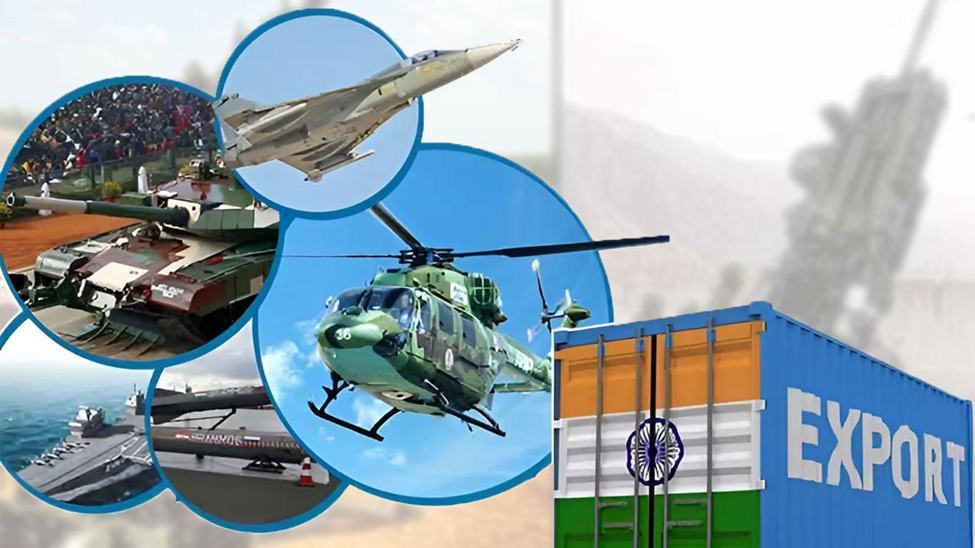India's Defence Exports Soar, Setting New Milestones
- InduQin
- Aug 19, 2024
- 3 min read
India's defence exports have surged, marking a 78% increase in the first quarter of 2024-2025. The government's proactive measures have streamlined processes, aiming to achieve Rs 35,000 crore in defence exports by 2025. The US is a significant partner, with American companies sourcing from India. India's diverse exports range from ammunition to drones. The country is fostering a comprehensive defence ecosystem, aiming to become an MRO hub. These efforts have positioned India as a major player in global defence exports.
India's journey in the realm of defence exports has been nothing short of remarkable, witnessing a meteoric rise over the past decade, with figures skyrocketing by more than 30 times. Today, the nation stands as a prominent supplier of defence products to over 90 countries, a feat fueled by escalating global conflicts such as the Russia-Ukraine war and the Israel-Hamas conflict. These geopolitical pressures have prompted many nations to bolster their military capabilities, with India emerging as a pivotal ally in meeting these demands. The recent statistics for the first quarter of 2024-2025 paint a vibrant picture, showcasing a phenomenal 78% surge in India's defence exports, marking a significant leap from Rs 3,885 crore to Rs 6,915 crore, as reported by ThePrint.
Empowering Growth Through Government Initiatives
Driving this export surge is the proactive role played by the Indian government, which has implemented policies aimed at streamlining licensing processes, approvals, and demonstrating a greater openness in supplying lethal arms. In a visionary move back in 2020, the Narendra Modi government set an ambitious target of achieving Rs 35,000 crore ($5 billion) in defence exports within five years. This forms part of a larger strategy to reach a turnover of Rs 1.75 lakh crore ($25 billion) in defence manufacturing by 2025. Recent data unveiled by the Ministry of Defence for 2023-2024 indicates a record-breaking figure of Rs 21,083 crore in defence exports, marking a notable 32.5% increase from the previous fiscal year.
Retired Lt Gen H S Panag shed light on this strategic pivot, emphasizing, "By 2013-14, our exports were a meagre $110 million. A defence export strategy did not exist until August 2014. Exports were carried out under the Foreign Trade Policy after obtaining a no-objection certificate (NOC) from the Ministry of Defence. In September 2014, the Modi government formulated and promulgated a Strategy for Defence Exports, focusing on export promotion/facilitation and regulation."
The US: A Strategic Partner in Defence
The United States has emerged as a pivotal market for Indian defence goods, accounting for nearly half of India's total defence exports. This robust trade relationship is underpinned by American companies sourcing systems, subsystems, and components from India as part of their global supply chains and offset commitments. Key players like Boeing and Lockheed Martin have solidified their presence in India, with Boeing's joint venture, Tata Boeing Aerospace Ltd (TBAL), manufacturing aero-structures for Boeing's AH-64 Apache helicopter in Hyderabad. Lockheed Martin's collaborations with Tata Advanced Systems Limited (TASL) have further bolstered economic ties, with significant contributions to the C-130J transport aircraft and S-92 helicopter.
Diverse Export Portfolio and Global Engagements
India's defence exports encompass a wide spectrum of products, ranging from ammunition, small arms like sniper rifles and bulletproof jackets, to advanced items such as lightweight torpedoes, drones, and fast-attack vessels. Leading the charge in private defence exports is Bengaluru-based Indo-MIM, specializing in metal injection molding (MIM) parts and supplying precision-engineered products to over 50 countries. State-run entities like Munitions India, a result of the Ordnance Factory Board's corporatization in 2021, have also made significant strides, achieving an export milestone of Rs 1,726 crore in ammunition and explosives in 2023-2024.
Fostering a Comprehensive Defence Ecosystem
Beyond exports, the Indian government's vision extends to nurturing a comprehensive defence ecosystem. Initiatives include establishing private assembly plants for military transport aircraft like the C-295 and commercial helicopters, paving the way for potential global markets. A government source emphasized the holistic approach, stating, "Along with a manufacturing base, the effort is to establish India as an MRO (Maintenance, Repair, and Overhaul) hub. All this is a work in progress."
India's burgeoning defence export market is a testament to strategic government policies, robust international demand, and fruitful partnerships with global defence giants like the US. With exports now spanning across 90 nations, India is rapidly cementing its position as a key player in the global defence arena. As the country continues to enhance its manufacturing capabilities and broaden its global engagements, it is well on track to realize its ambitious targets and solidify its status as a major defence exporter.








Comments